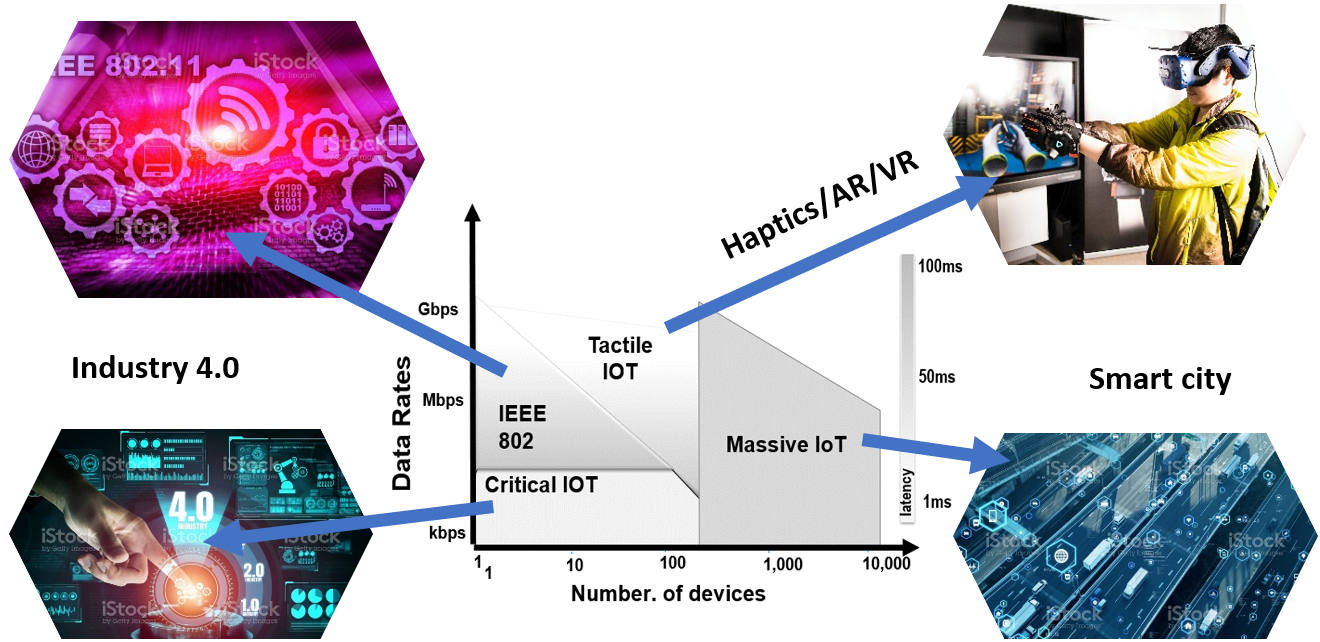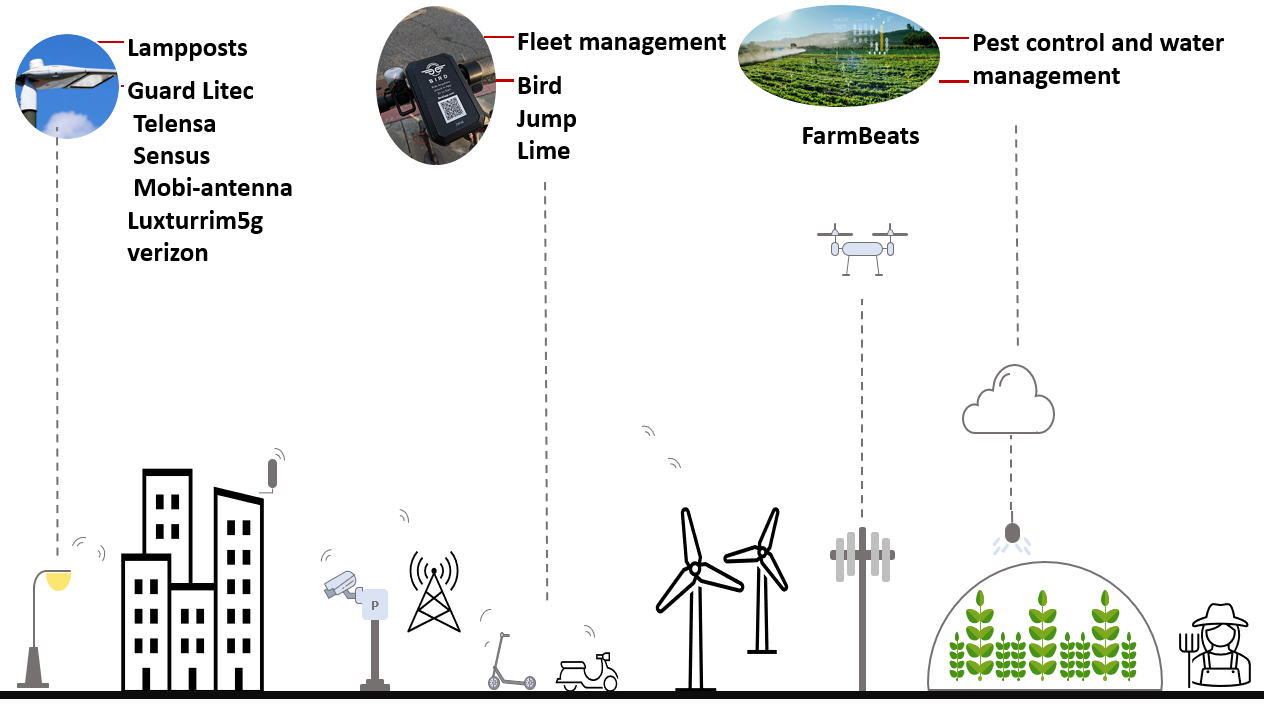Published on: Mar 24, 2023
IoT devices are physical objects, they can be sensors, machines, smart vehicles, etc. that are connected to the Internet to collect/exchange data and information. A growing market of more than 30.2 billion devices with IoT connections will be deployed by 2027 [1]. The Internet of Things (IoT) market can be segmented based on the number of devices, data rate, and latency, as follows:
- Number of Devices: This segmentation is based on the number of IoT devices and sensors deployed in a given system. It can be further divided into small-scale systems with a few devices, and large-scale systems with thousands or even millions of devices.
- Data Rate: This segmentation is based on the amount of data generated and transmitted by IoT devices and sensors. It can be further divided into low-data rate systems with a few kilobits per second (Kbps), and high-data rate systems with several megabits per second (Mbps) or even gigabits per second (Gbps).
- Latency: This segmentation is based on the amount of time it takes for data to cover the distance between an IoT device and a central hub or cloud platform. They can be low-latency systems with real-time or near-real-time data transmission, and high-latency systems with slower data transmission times.
Each of these segments can have different requirements and demands in terms of technology, infrastructure, and services. Massive IoT, IEEE 802, Critical IoT, and Tactile IoT are terms used to describe different aspects of the Internet of Things (IoT) technology.
- IEEE 802: Refers to a set of wireless communication standards developed by the Institute of Electrical and Electronics Engineers (IEEE). This segment is often referred to as “human-type networks” and is characterized by relatively small network sizes and data rates up to 10 Gbps [2].
- Critical IoT: Refers to IoT applications that require real-time and critical performance, such as those used in Industry 4.0. This segment requires low latency (1ms to 10ms) and high reliability (99.9999%) and is also referred to as Ultra-Reliable Low-Latency Communications (URLLC). In this segment, security and robustness against external attacks and threats are of utmost importance. [3].
- Tactile IoT: Refers to IoT applications that focus on touch and physical interaction, such as haptic feedback in virtual and augmented reality systems. This segment demands high data rates [4].
- Massive IoT: Refers to large-scale IoT networks that handle huge amounts of data from numerous devices and sensors. This segment is characterized by the need for high data rates and low latency. For more details read LPWANs (Cellular Low Power Wide Area Networks) [4].

Fig. 1. IoT market segmentation according to the number of device, data rate and latency [5].
Massive IoT Applications
Massive IoT has many applications in smart city deployments. Using massive IoT for smart street lights, electric scooter mobility and smart agriculture are some examples where the sensors are connected and managed as shown in Fig. 2.
The massive IoT is used in dense regions with high connection density and wide area coverage. In other words, the number of devices per base station is between 1000 to 10,000 devices. The regions covered per based station are wide, for example, 10^5 m2 area.
The factor of massive IoT in terms of communication is that it is predominantly operated in uplink. The downlink is mostly for controlling the machines. A limiting factor of IoT is data rate, that for some devices such as sensors the data rate is low, however for some devices such as virtual reality cameras the data rate is high. In other words, a temperature sensor requires a low data rate link compared to a traffic camera which requires higher data rate links.

Fig. 2. Massive IoT applications in smart cities and agriculture [6].
Challenges and requirements for massive IoT
Massive IoT has to deal with lack of dedicated spectrum and high density of battery-powered devices. As shown in Fig. 3, the IoT network solutions are classified based on whether they use licensed or unlicensed spectra. Licensed spectrum refers to frequency bands that are exclusively allocated to specific organizations or entities by a regulatory body, for a specific purpose, such as communication. In the context of IoT, licensed spectrum is typically used for cellular networks, where organizations pay for the exclusive use of a frequency band for their communication needs. Unlicensed spectrum, on the other hand, refers to frequency bands that are open for public use and do not require a specific license. In the context of IoT, unlicensed spectrum is typically used for short-range wireless communication technologies, such as Wi-Fi, Zigbee, and Bluetooth. Both licensed and unlicensed spectrum have their advantages and disadvantages. Licensed spectrum is typically more reliable and provides better coverage and capacity, but it also comes at a higher cost. Unlicensed spectrum is typically less expensive, but it may also be less reliable and provide less capacity. Classifying IoT network solutions based on whether they use licensed or unlicensed spectrum can be useful for understanding the trade-offs and requirements for different types of IoT applications and use cases, and for selecting the most appropriate solution for a given context. Sigfox, LoRa, and Ingenu are examples of Low Power Wide Area Network (LPWAN) technologies that operate in the unlicensed spectrum. Sigfox uses the Industrial, Scientific, and Medical (ISM) band, while LoRa operates in the sub-gigahertz frequency band and Ingenu operates in the 2.4 GHz band. These technologies are designed to provide long-range connectivity for IoT devices and are characterized by low power consumption and low data rates.
In terms of the spectrum, some IoT services use an unlicensed spectrum to avoid payments and reduce the cost. However, using an unlicensed spectrum is crowded with other networks that cause interference. However, some IoT networks have licensed spectrum to avoid interference. Regarding the unlicensed spectrum, there are certain regulations such as power level, duty cycle, or listen-before talk requirements.
Fig. 3. Classification of IoT networks based on license and unlicensed spectrum band.
In conclusion, the selection of spectrum for IoT network solutions is critical to ensure reliable, efficient and cost-effective communication between devices. The use of licensed or unlicensed spectrum depends on various factors such as coverage requirements, data rates, power consumption, and cost considerations. While licensed spectrum provides better reliability and capacity, it comes at a higher cost. In contrast, unlicensed spectrum is less expensive, but its reliability and capacity may be limited due to interference from other networks. The classification of IoT network solutions based on the spectrum they use can assist in selecting the most appropriate solution for a given context. Low Power Wide Area Network (LPWAN) technologies such as Sigfox, LoRa, and Ingenu that operate in the unlicensed spectrum are designed to provide long-range connectivity for IoT devices while minimizing power consumption and data rates. The proper selection and management of spectrum are essential to ensure the success of IoT applications and their ability to deliver their intended benefits.
If you were able to stick until the end and can’t wait for more content and you also want to know about us and our projects, you can always follow our social media channels.
References
[1] Update, Interim, “Ericsson mobility report” Ericsson: Stockholm, Sweden, 2018.
[2] Ghasempour, Yasaman, et al. “IEEE 802.11 ay: Next-generation 60 GHz communication for 100 Gb/s Wi-Fi.” IEEE Communications Magazine 55.12 (2017): 186-192.
[2] B. Chen, J. Wan, L. Shu, P. Li, M. Mukherjee, and B. Yin, “Smart Factory of Industry 4.0: Key Technologies, Application Case, and Challenges,” in IEEE Access, 2018.
[3] M. Simsek, A. Aijaz, M. Dohler, J. Sachs and G. Fettweis, “5G-Enabled Tactile Internet,” in IEEE JSAC, Mar. 2016.
[4] Series, M. “IMT Vision–Framework and overall objectives of the future development of IMT for 2020 and beyond”, Recommendation ITU 2083, 2015.
[5] E. Dahlman, S. Parkvall, and J. Skold, “5G NR: The next generation wireless access technology”, Academic Press, 2020.
[6] C. Oestges, and F. Quitin, eds, “Inclusive radio communications for 5G and beyond”, Academic Press, 2021.


